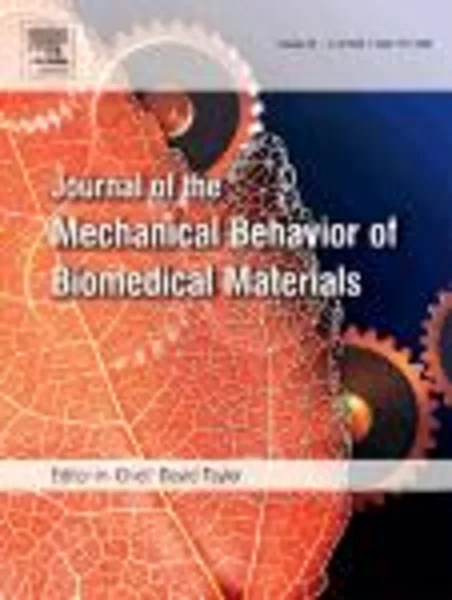-
bond strength of five dental adhesives using a fracture mechanics approach
جزئیات بیشتر مقاله- تاریخ ارائه: 1394/01/01
- تاریخ انتشار در تی پی بین: 1394/01/01
- تعداد بازدید: 873
- تعداد پرسش و پاسخ ها: 0
- شماره تماس دبیرخانه رویداد: -
objectives : the adhesion tests utilized in dentistry are unable to separate the effects of adhesive composition, substrate properties, joint geometry and type of loading on the measured bond strength. this makes it difficult for the clinician to identify the most suitable adhesive for a given procedure and for the adhesive manufacturer to optimize its composition. thus, an adhesion test protocol based on the fracture mechanics has been proposed to generate data for which separation of the effect of composition from that of the joint geometry on the shear (τa) and tensile (σa) bond strengths was possible for five commercial dental adhesives. methods: planar 40×5×5 mm3 sections of bovine femur were used as model adherends. the adhesive thickness (h) was varied from 15 to 500 μm. commercial adhesives with fracture toughness (kic) ranging from 0.3 to 1.6 mpa m1/2 were used. double lap joint (dlj) and modified compact tension (mct) specimens were conditioned for 24 h in 37 °c distilled water, then dried in a vacuum oven at 37 °c for 24 h prior to testing. the thickness dependence of σa and τa was measured at constant strain rate and analyzed using the interface corner stress intensity factor model. results : both τa and σa increased with increasing adhesive thickness, exhibiting a maximum bond strength at the optimum thickness (hopt). for h<hopt, both τa and σa were proportional to h, and, above hopt, both τa and σa decreased with h−4/10 in agreement with the fracture mechanics predictions. hence, two geometry-independent material parameters, ψ and (hc/q), were found to characterize τa and σa over the entire thickness interval. significance : the adhesion tests currently used in dentistry provide the geometry-dependent bond strength, and such data cannot be used either for prediction of clinical reliability of commercial dental adhesives or for development of new ones. the proposed test protocol allowed us to determine two composition-only dependent parameters determining τa and σa. a simple proposed procedure can then be used to estimate the weakest point in clinically relevant joints always exhibiting varying adhesive thickness and, thus, to predict the locus of failure initiation. moreover, this approach can also be used to analyze the clinical relevance of the fatigue tests of adhesive joints.
مقالات جدیدترین رویدادها
-
استفاده از تحلیل اهمیت-عملکرد در ارائه الگوی مدیریت خلاقیت سازمانی و ارائه راهکار جهت بهبود
-
بررسی تاثیر ارزش وجوه نقد مازاد بر ساختار سرمایه شرکت های پذیرفته شده در بورس اوراق بهادار تهران
-
بررسی تأثیر سطح افشای ریسک بر قرارداد بدهی شرکت های پذیرفته شده در بورس اوراق بهادار تهران
-
بررسی تأثیر رتبه بندی اعتباری مبتنی بر مدل امتیاز بازار نوظهور بر نقد شوندگی سهام با تأکید بر خصوصی سازی شرکت ها
-
تأثیر آمیخته بازاریابی پوشاک ایرانی بر تصویر ذهنی مشتری پوشاک ایرانی (هاکوپیان)
-
مقایسه پژوهش در زمینه بهینه سازی مصرف انرژی در ایران و ژاپن
-
بررسی و اولویت بندی هوش اخلاقی
-
نقش محوری طلا در هنر تشعیرسازی
-
بررسی الگوریتم های زمانبندی در وایمکس
-
numerical simulation of uniform flow region over a steeply sloping stepped spillway
مقالات جدیدترین ژورنال ها
-
مدیریت و بررسی افسردگی دانش آموزان دختر مقطع متوسطه دوم در دروان کرونا در شهرستان دزفول
-
مدیریت و بررسی خرد سیاسی در اندیشه ی فردوسی در ادب ایران
-
واکاوی و مدیریت توصیفی قلمدان(جاکلیدی)ضریح در موزه آستان قدس رضوی
-
بررسی تاثیر خلاقیت، دانش و انگیزه کارکنان بر پیشنهادات نوآورانه کارکنان ( مورد مطالعه: هتل های 3 و 4 ستاره استان کرمان)
-
بررسی تاثیر کیفیت سیستم های اطلاعاتی بر تصمیم گیری موفق در شرکتهای تولیدی استان اصفهان (مورد مطالعه: مدیران شرکتهای تولیدی استان اصفهان)
-
بررسی درک مصرف کننده از فعالیت های بازاریابی رسانه های اجتماعی بر ارزش گذاری برند، پاسخ مشتری و قصد خرید
-
بررسی تأثیر استراتژی مدیریت تنوع محصول بر عملکرد زنجیره تأمین در صنعت خودروسازی
-
عوامل طغیان و کنترل شهوت جنسی با نگاه قرآنی - حدیثی
-
تحلیل جایگاه صنعت گردشگری در توسعه استان ایلام و تدوین استراتژی توسعه بر پایه بخش گردشگری
-
green envelop impact on reducing air temperature and enhancing outdoor thermal comfort in arid climates




سوال خود را در مورد این مقاله مطرح نمایید :